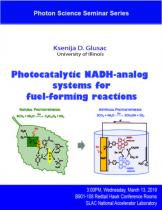Speaker: Ksenija D. Glusac
Program Description:
In photosynthetic organisms, CO2 reduction is achieved via hydride transfer from NADH cofactors, while the catalytic cycle is closed using photochemical reduction of NAD+ by water. In our work, we attempt to mimic this chemistry using artificial NADH analogs adsorbed on photocathode surface for photochemical regeneration (see figure). In this biomimetic approach, the selectivity for methanol production will be achieved, while the undesired proton reduction will be suppressed by metal-free catalysts.
We studied the photochemical recovery of a series of NADH-analogs using GaP photocathode and found that the NAD+ analogs with sufficiently long excited-state lifetimes can serve as photo-sensitizers, which leads to an increase in the light-harvesting efficiency of the GaP-NAD+ system. The second investigation involved the determination of thermodynamic hydricities of a series of NADH analogs. This study provided the structure-property relationships in model compounds and the results have pinpointed two molecular motifs that show promise as potential catalysts for CO2 reduction. This study provides important mechanistic insights into the CO2 reduction by metal-free catalysts.





